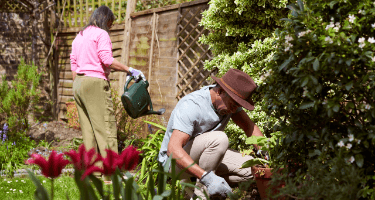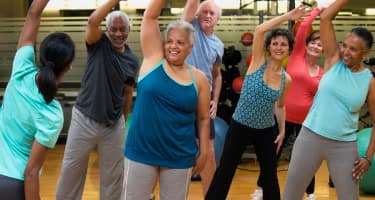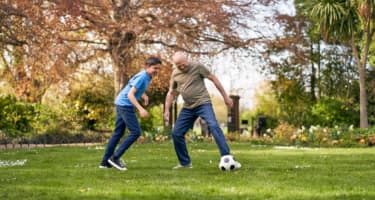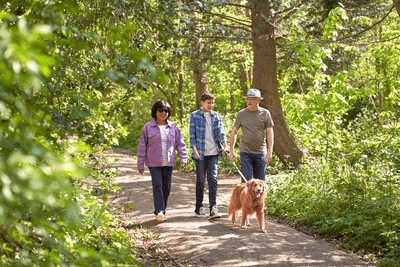Coping physically with cancer
This information is about being more active during treatment and beyond.
We also have information on physical activity for people about to start treatment in our prehabilitation section.
Read more about how you can physically prepare for cancer treatment
Being physically active means any movement that uses your muscles and more energy than when you’re resting. Being physically active doesn’t have to mean joining a gym or an exercise class. It can also be walking to the shops, walking up the stairs, gardening or dancing.
Physical activity can also be of a:
moderate intensity – this is when the activity makes you feel warmer and breathe faster, but you can still talk. For example, brisk walking, cycling, swimming, gardening or housework
vigorous intensity – this is an activity that raises your heart rate and makes you start to sweat and feel out of breath. For example, running, aerobics, netball, football and fast cycling

‘It’s tough at first, but it makes you feel stronger and more human. As with “normal” life, exercise is important - don’t be limited by cancer.’ - Patrick
How active you are and what type of activity you can and want to do will depend on:
the type of cancer you have
your treatment and any side effects you have
how physically active you are already
what activities you enjoy
In general, if you have cancer, you should check with your doctor before starting any exercise.

Some research shows that being more physically active may help to reduce the risk of:
some cancers coming back
some 1 cancers from growing further
Other factors that may reduce the risk of cancer coming back are:
how much body fat you have
your diet
the amount of alcohol you drink
Physical activity after diagnosis may reduce the risk of dying from the following cancers:
breast
bowel
prostate
cervix, womb and ovarian
There is also some research showing that being more sedentary after a diagnosis of bowel, prostate or kidney cancer is linked with a higher risk of dying from cancer. Some of this evidence is from single studies. So we need more research to confirm this.
Structured physical activity can improve the chances of surviving colon cancer. Cancer survival means the percentage of people still alive after a particular amount of time. A 2025 study showed that people survived their cancer for longer if they:
were supported in an exercise programme over 3 years
started the programme soon after having chemotherapy
Read more on the Cancer Research UK Cancer News page
Moderate and vigorous physical activity may reduce the risk of cancers of the:
bowel (colon only)
breast – in women who have had their menopause (postmenopausal)
womb (endometrium)
Vigorous physical activity may also reduce the risk of breast cancer in women who haven’t had their menopause (premenopausal).
Research is still ongoing on why this might be, but most of the benefits of physical activity are linked to being a healthy weight.
Read more about physical activity and reducing the risk of getting cancer
Researchers are interested in finding out more about exercise and cancer.
They are looking at how exercise can improve survival in people with lung, breast and bowel cancer. This study is also looking at how exercise reduces the chances of these cancers coming back. People taking part receive a personalised exercise programme shortly after they have finished cancer treatment.
In another study, researchers are using a mobile for physical activity to help people with breast, prostate, or bowel cancer become more active. People taking part will also receive support and guidance from specialists.
Read more about clinical trials on exercise and cancer

Being physically active has several benefits for people with cancer. These include:
reducing anxiety
improving depression
improving sleep quality and reducing difficulty falling or staying asleep (insomnia)
reducing fatigue and pain
improving your overall enjoyment of life (quality of life)
improving body strength
reducing treatment side effects such as heart changes, nerve changes (peripheral neuropathy) during or after chemotherapy, thinking problems (cognitive impairment) and shortness of breath
improving physical health in women with breast cancer who develop lymphoedema (a type of swelling caused by treatment to lymph nodes)
improving general physical functioning
Researchers think that adding exercise to cancer treatment plans could help people cope better, but more research is needed. This will help us know how exactly exercise helps and to provide exercise prescriptions according to the type of cancer you have.
Some early studies show that physical activity may help treatment work better, but we need more research to understand this better.
Physical activity also:
reduces the risk of getting type 2 diabetes or heart disease
reduces falls
improves joint and back pain
It is not uncommon for people with cancer or who have finished treatment to struggle with:
the effects of cancer on their mental health
the side effects of treatment
For some people, these factors may be long-term, and they may be a barrier to being physically active. They include:
anxiety and depression
fatigue
sleeping problems
nerve changes (peripheral neuropathy)
weakened bones
changes to the heart muscle (cardiomyopathy)
loss of a limb (amputation)
chronic swelling (lymphoedema) in a limb
It is difficult to write exercise guidelines to cover everyone. Everyone is different in terms of how much exercise they can do. And there are many types of cancer and treatments. The UK government and the World Cancer Research Fund (WCRF) have suggestions for preventing cancer and other conditions. They say that all adults should try to be physically active every day. This includes people with cancer.
Try to do at least one of the following ways of exercising or a combination of both:
150 minutes of moderate intensity activity per week, for example, 30 minutes 5 times per week. An example of how to make up 30 minutes of exercise includes: - in the morning: housework – 5 minutes - in the afternoon: walk to the shop or walk the dog – 20 minutes - throughout the day: walk up and down the stairs – 5 minutes
75 minutes of vigorous activity per week

All adults should also try and do strength (resistance) training twice a week. These are exercises that build muscle strength and endurance by working against resistance. Examples include:
weight lifting
bodyweight exercises
resistance band workouts – using exercise elastic bands to create resistance
carrying heavy shopping
Adults should also try to improve their balance and flexibility (stretching) twice a week. Balance activities improve stability, coordination and prevent falls. Examples include:
Tai Chi
single leg exercises such as standing on one leg while brushing your teeth
stability ball exercises – using a large inflatable ball to exercise
Read more about balance exercises on the NHS website
Flexibility activities improve the range of motion of muscles and joints, helping with mobility and injury prevention. Examples include:
yoga
static stretching – holding a stretch in a fixed position for 15 to 60 seconds
dynamic stretching – doing controlled movements through a full range of motion
Read more about flexibility exercises on the NHS website
Adults should also try to reduce the amount of time they are sedentary. This means watching TV or working on a computer for long hours without a break. Try to break up these periods of inactivity with light physical activity.
‘If you can, exercise with friends. Greater motivation, more support, more fun. You’d be amazed how many people will get involved, not out of pity but because they want to. Amazing what you talk about when exercising - very therapeutic for everyone.’ - Patrick
It's fine to start being more active whether:
you have just been diagnosed
you're having treatment
you have recently finished treatment
How much you do depends on how fit you are generally. You can start by making a few small changes. For example, you could start by walking around your house or walking around the block or even getting off the bus one stop early.

If you aren't very physically active, you'll need to build up gradually. If you do too much one day, you might feel very tired and sore the next day. Don't feel that you always have to do more than yesterday. Some days you'll have more energy than others.
Start with short chunks (10 to 15 minutes) of gentle activity. Then, gradually build up until you reach your target.
Try to stay active. You can break up periods of rest with activities around the house, for example, mowing the lawn or ironing.
Find activities that are enjoyable, as you are more likely to stick to them. But try not to let past lack of activity put you off starting altogether. Gentle walking or swimming is fine for just about everyone. You can still build up day by day.
You can also join the charity Move Against Cancer. They help people living with cancer to get active with others.
Read more on the Move Against Cancer website
Read about how to be more active
People with certain types of cancer or having particular treatments might need to avoid some types of exercise. There are some situations where you need to take extra care.
If you have cancer affecting your bones, you might be more at risk of a break or fracture. You must avoid putting too much strain on the affected bones. Avoid exercises causing a twist in your spine, such as:
yoga style twists
using the rowing machine
swinging in golf and tennis
People with low immunity due to treatment should try to avoid exercising in public gyms. Ask your medical team when it is safe to start exercising in the gym with other people. This doesn’t mean you can’t be physically active in other ways.
Some people have a loss of sensation, or feelings of pins and needles, in their hands and feet. This can be due to cancer treatments. It is called peripheral neuropathy. If you have this, it might be better to use a stationary bike than to do other types of weight bearing exercise.
After certain types of surgery, you might have to wait before you can exercise like you used to. Or if you have had surgery that caused permanent changes, you may need to take certain precautions. For example, you have a or after surgery. Talk to your doctor or specialist nurse for advice on what types of exercise you can do.
Some people may need to take extra care in the sun when exercising outside. These include those:
with a diagnosis of melanoma skin cancer
with cancer where there is a risk of it spreading to the skin
We have information for people who have finished cancer treatment and are looking for information and support.
Last reviewed: 27 May 2025
Next review due: 27 May 2028
Yoga aims to bring balance to your body and mind. Some people with cancer say it helps calm their mind so that they can cope better with their cancer and its treatment.
It's important to exercise to help manage a build up of lymph fluid (lymphoedema). They can help you to keep a full range of movement and make you feel better.
Find out about managing cancer symptoms and possible side effects from cancer treatment. There is information about pain, sickness, diet problems and much more.
Search for the cancer type you want to find out about. Each section has detailed information about symptoms, diagnosis, treatment, research and coping with cancer.
Cancer and its treatment can cause extreme tiredness known as fatigue. There are ways this can be treated.
Making small changes to your daily routine can help you be more active. Aim to be active every day, any amount of activity is good for you.

About Cancer generously supported by Dangoor Education since 2010. Learn more about Dangoor Education
Search our clinical trials database for all cancer trials and studies recruiting in the UK.
Connect with other people affected by cancer and share your experiences.
Questions about cancer? Call freephone 0808 800 40 40 from 9 to 5 - Monday to Friday. Alternatively, you can email us.